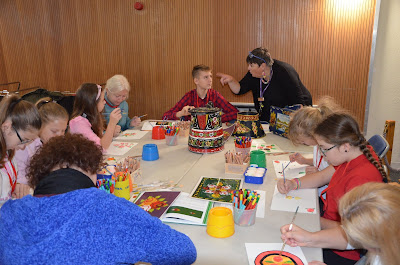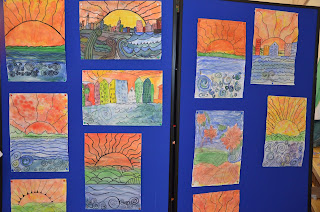Erasmus students worked together to produce this tempera block paint pictures
Monday 25 November 2019
Saturday 23 November 2019
WATER AND CULTURE - BANBURY MUSEUM AND OXFORD CANAL
Banbury Museum is on the Oxford canal. There were many canals built in the late 18th and early 19th centuries, to carry goods around the country. They were quite narrow waterways and the boats on them had to be narrow too. For this reason they are called narrowboats. Each narrowboat was usually operated by a family who lived in the small cabin at the back. These people had a culture all of their own.
The narrowboat families decorated their boats with a design of flowers special to the canals. Everyone had the chance to try and paint some of these designs.
The canal people painted the doors and panels of their boats and also painted their water jugs, buckets plates etc.
Taking a trip on the canal. Nowadays the canals are used mostly for leisure. The narrowboats are converted so that people can enjoy trips or take holidays living on the boats for a weekend or longer. Some people even live on their boats all year round.
Canal people also had a particular style of dress.
Pulling a boat on a canal is much easier than on land. One horse could pull the boat. There are no hills on canals. To get from one height to another a lock is used.
Droppy is enjoying his cruise.
A transport used by people from the small villages, to come to the town.
A project boat?
The whole length of this boat is now living accomodation.
Canal people also painted fairy tale scenes on their boats
Lovely boating weather!
WATER AND CULTURE MEETING IN GLORY FARM - 14-19 October 2019
Pupils looked at the important role of water in human culture. Between this meeting and the previous one, as part of their normal studies, schools studied the impact of water on the cultural development of their locality and country. The pupils studied its influences on all art forms, including literature, poetry, film, theatre, fine arts, architecture and music, and also traditions, food and customs. Before the meeting, pupils at each school looked at how water has influenced their cultural life and prepared a short presentation. This took the form of a small exhibition of artwork, written work, photos and models which were on display during the week. There was also a ten-minute presentation made to an audience of host school members as well as visitors.
ART WORK PRODUCED IN 6 COUNTRIES
During the meeting participants studied how water has exerted an influence on cultural development in our lives. The host school showed aspects of its local cultural development with a visit to the nearby city of Oxford, a world-renowned cultural centre which was founded where the River Thames meets the River Cherwell (known locally as the Isis). Whilst there, they visited the famous University which dates from the 12th Century and which has been at the forefront of developing ideas that have not only influenced the lives of people in this country but many more world-wide. They also visited the world’s first public museum, the Ashmolean, which houses a collection of art and artefacts from around the world.
ART WORK PRODUCED IN 6 COUNTRIES
RESULTS PRESENTATION
On the first day there was a welcome assembly run by headteacher
Ms Jane MacLachlan and pupil performed some songs and dances.
During the meeting participants studied how water has exerted an influence on cultural development in our lives. The host school showed aspects of its local cultural development with a visit to the nearby city of Oxford, a world-renowned cultural centre which was founded where the River Thames meets the River Cherwell (known locally as the Isis). Whilst there, they visited the famous University which dates from the 12th Century and which has been at the forefront of developing ideas that have not only influenced the lives of people in this country but many more world-wide. They also visited the world’s first public museum, the Ashmolean, which houses a collection of art and artefacts from around the world.
OXFORD
On another day there was a visit to Stratford upon
Avon to visit the home of William Shakespeare, whose cultural influence spreads
far beyond the local area and who will be familiar to the participants from all
countries.
STRATFORD UPON AVON
As well as their work, the pupils will discover some
of the leisure related water activities that are part of British culture. This
will include relaxing on the river in a boat or punt and taking a trip on the
Oxford canal, once part of the national canal system used by working boats
transporting goods around the country but now almost exclusively used for
leisure.
At the school the pupils had workshops on aspects of
film-making from developing an idea, to storyboarding and to filming. As a
group, the visiting children and their hosts made a film using the neighbouring
secondary school’s film and TV studio. They learnt about directing, acting,
lighting, sound and production as well as exploring special effects such as
green screen. These skills will be invaluable in the production of their final
documentary for the project and will also serve them well in any presentational
work they undertake in the future. As part of the workshops the pupils
considered how water has inspired artists, authors and composers and explored
their own interpretations of water. The conservation of water also came into
these thoughts because the influence of water on our lives and cultures will
continue into the future. These considerations will provide a basis for the
subject matter when they begin their film-making.
During the week the Mayor of Bicester hosted a meeting
at the Town Council Chamber and talked to the children about the town and how
it is run.
STALLS
Traditionaly all partners organised stalls presenting their schools, towns, countries. There were some snacks and souvenirs made by pupils. Chair of Governors Mr Mike Waine visited school that day.
In the end all received certificates
Subscribe to:
Posts (Atom)












































































